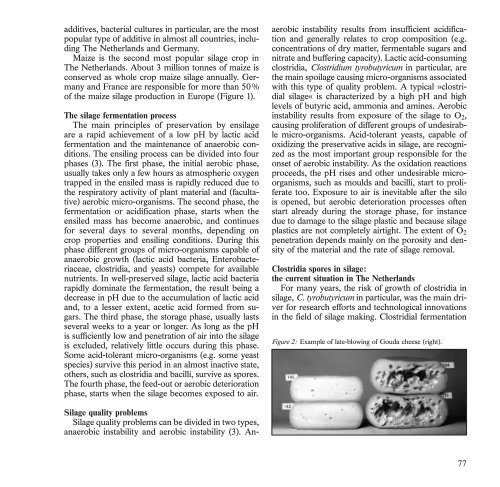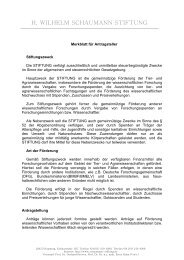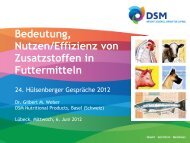Broschüre 2004 zum Download (pdf | 1994,28 KB) - H. Wilhelm ...
Broschüre 2004 zum Download (pdf | 1994,28 KB) - H. Wilhelm ...
Broschüre 2004 zum Download (pdf | 1994,28 KB) - H. Wilhelm ...
Erfolgreiche ePaper selbst erstellen
Machen Sie aus Ihren PDF Publikationen ein blätterbares Flipbook mit unserer einzigartigen Google optimierten e-Paper Software.
additives, bacterial cultures in particular, are the most<br />
popular type of additive in almost all countries, including<br />
The Netherlands and Germany.<br />
Maize is the second most popular silage crop in<br />
The Netherlands. About 3 million tonnes of maize is<br />
conserved as whole crop maize silage annually. Germany<br />
and France are responsible for more than 50 %<br />
of the maize silage production in Europe (Figure 1).<br />
The silage fermentation process<br />
The main principles of preservation by ensilage<br />
are a rapid achievement of a low pH by lactic acid<br />
fermentation and the maintenance of anaerobic conditions.<br />
The ensiling process can be divided into four<br />
phases (3). The first phase, the initial aerobic phase,<br />
usually takes only a few hours as atmospheric oxygen<br />
trapped in the ensiled mass is rapidly reduced due to<br />
the respiratory activity of plant material and (facultative)<br />
aerobic micro-organisms. The second phase, the<br />
fermentation or acidification phase, starts when the<br />
ensiled mass has become anaerobic, and continues<br />
for several days to several months, depending on<br />
crop properties and ensiling conditions. During this<br />
phase different groups of micro-organisms capable of<br />
anaerobic growth (lactic acid bacteria, Enterobacteriaceae,<br />
clostridia, and yeasts) compete for available<br />
nutrients. In well-preserved silage, lactic acid bacteria<br />
rapidly dominate the fermentation, the result being a<br />
decrease in pH due to the accumulation of lactic acid<br />
and, to a lesser extent, acetic acid formed from sugars.<br />
The third phase, the storage phase, usually lasts<br />
several weeks to a year or longer. As long as the pH<br />
is sufficiently low and penetration of air into the silage<br />
is excluded, relatively little occurs during this phase.<br />
Some acid-tolerant micro-organisms (e.g. some yeast<br />
species) survive this period in an almost inactive state,<br />
others, such as clostridia and bacilli, survive as spores.<br />
The fourth phase, the feed-out or aerobic deterioration<br />
phase, starts when the silage becomes exposed to air.<br />
Silage quality problems<br />
Silage quality problems can be divided in two types,<br />
anaerobic instability and aerobic instability (3). Anaerobic<br />
instability results from insufficient acidification<br />
and generally relates to crop composition (e.g.<br />
concentrations of dry matter, fermentable sugars and<br />
nitrate and buffering capacity). Lactic acid-consuming<br />
clostridia, Clostridium tyrobutyricum in particular, are<br />
the main spoilage causing micro-organisms associated<br />
with this type of quality problem. A typical »clostridial<br />
silage« is characterized by a high pH and high<br />
levels of butyric acid, ammonia and amines. Aerobic<br />
instability results from exposure of the silage to O 2 ,<br />
causing proliferation of different groups of undesirable<br />
micro-organisms. Acid-tolerant yeasts, capable of<br />
oxidizing the preservative acids in silage, are recognized<br />
as the most important group responsible for the<br />
onset of aerobic instability. As the oxidation reactions<br />
proceeds, the pH rises and other undesirable microorganisms,<br />
such as moulds and bacilli, start to proliferate<br />
too. Exposure to air is inevitable after the silo<br />
is opened, but aerobic deterioration processes often<br />
start already during the storage phase, for instance<br />
due to damage to the silage plastic and because silage<br />
plastics are not completely airtight. The extent of O 2<br />
penetration depends mainly on the porosity and density<br />
of the material and the rate of silage removal.<br />
Clostridia spores in silage:<br />
the current situation in The Netherlands<br />
For many years, the risk of growth of clostridia in<br />
silage, C. tyrobutyricum in particular, was the main driver<br />
for research efforts and technological innovations<br />
in the field of silage making. Clostridial fermentation<br />
Figure 2: Example of late-blowing of Gouda cheese (right).<br />
77











